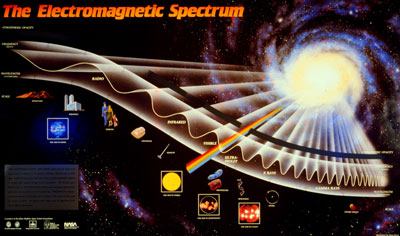Modeling the Electromagnetic Spectrum

Models are necessary in helping us understand relationships, but they can also be misleading. To use models effectively, it is important to understand how a model may be different from what it represents. You are familiar with models - we use them to help us "see" things that are too large for us to see - such as the Milky Way Galaxy - and things that are too small, such as the structure of an atom. Models can also help us understand what happens when the time it takes for things to happen is very long - the orbit of a comet for example. Models can take many forms. Some are physical models, such as maps and the chart of the electromagnetic spectrum pictured above, for example. Others are mental models, such as the Bohr model of the atom that comes to mind when we think of atoms. Still other models are mathematical, such as the equations that model the curvature of spacetime, which is impossible to make into a physical model, or even into a mental image. We use many models to help us visualize and understand ideas.
All of these models have distortions. Flat maps of the Earth get more exaggerated towards the edges - putting a round shape onto a flat surface causes some of the countries to look larger than they really are. The larger the concept the model is describing, the larger the amount of distortion in the model. However, models are still useful because they help us see relationships, and because they are convenient. A flat map may be folded up and put in your pocket. So there are trade-offs between accuracy and convenience whenever you construct a model.

Modeling the Electromagnetic Spectrum consists of a demonstration which illustrates the power of models, a pre-assessment activity on student understanding of exponents, an activity for students to construct and compare a different model of the spectrum than the model commonly used in textbooks and on posters, and an assessment task for students to construct their own models of the electromagnetic spectrum.
Modeling the Electromagnetic Spectrum: Middle School
Modeling the Electromagnetic Spectrum: High School
Useful Resources:
- Illustrations: http://chandra.harvard.edu/resources/illustrations/elec_mag_spec.html
- The Multiwavelength Milky Way: http://mwmw.gsfc.nasa.gov/
- A Tour of the Electromagnetic Spectrum: https://science.nasa.gov/ems
- Logarithm Tutorial Websites:
- Understanding Mathematics by Peter Alfeld, Dept. of Mathematics, University of Utah. Has a logarithm calculator.
http://www.math.utah.edu/~alfeld/math/log.html
- Understanding Mathematics by Peter Alfeld, Dept. of Mathematics, University of Utah. Has a logarithm calculator.
- Powers of Ten Visual Journey http://micro.magnet.fsu.edu/primer/java/scienceopticsu/powersof10/index.html
This page is also available in pdf.


